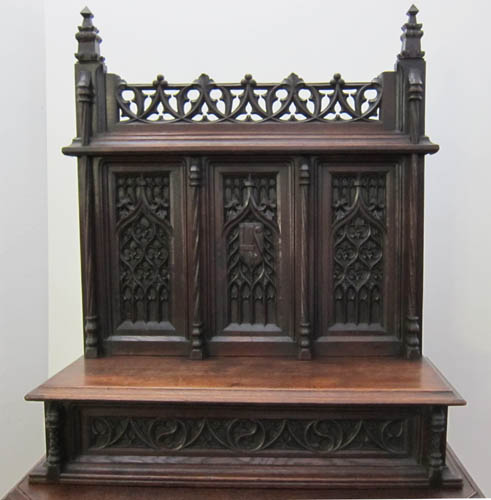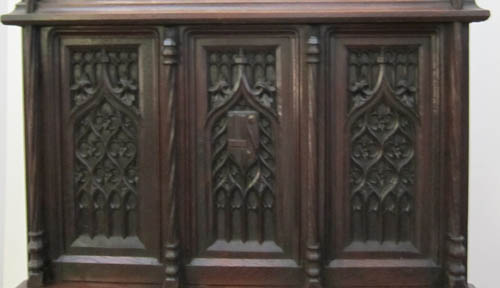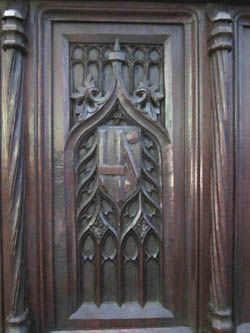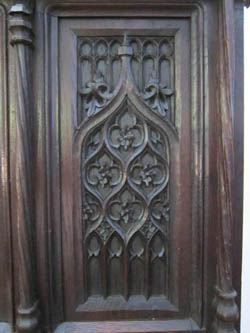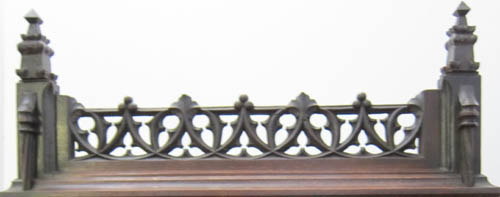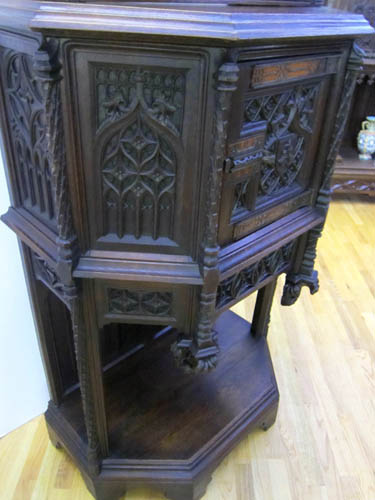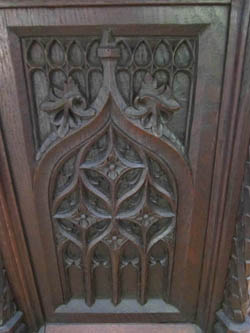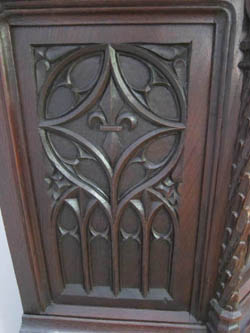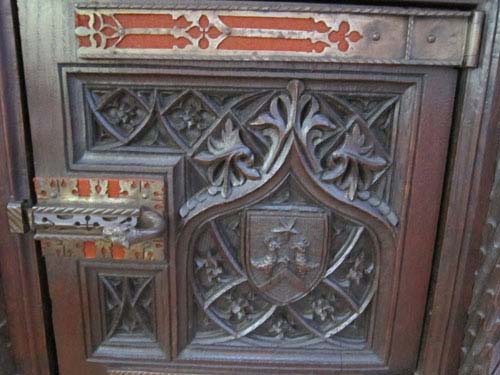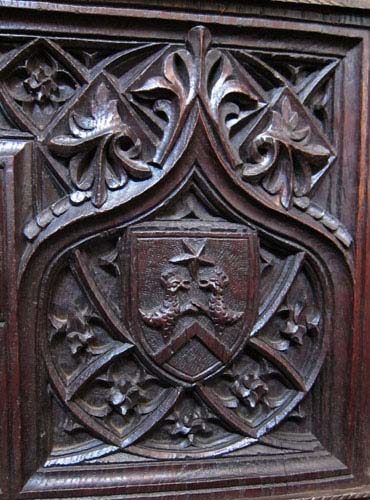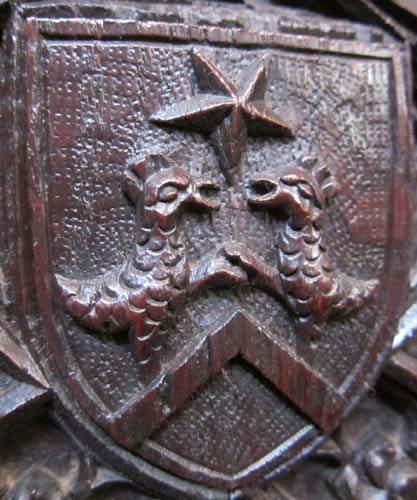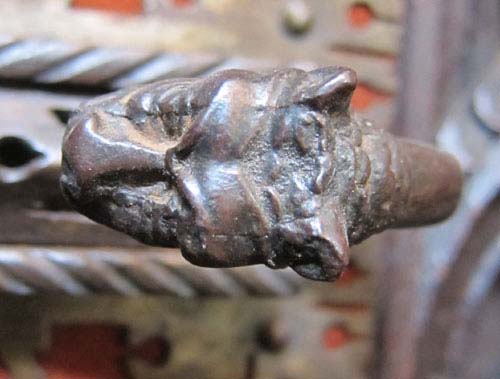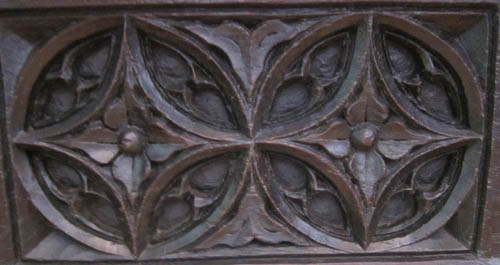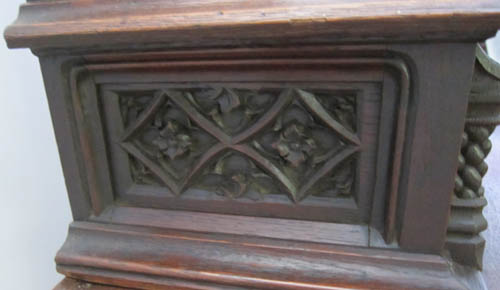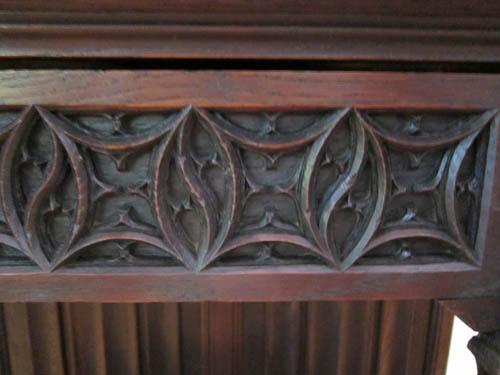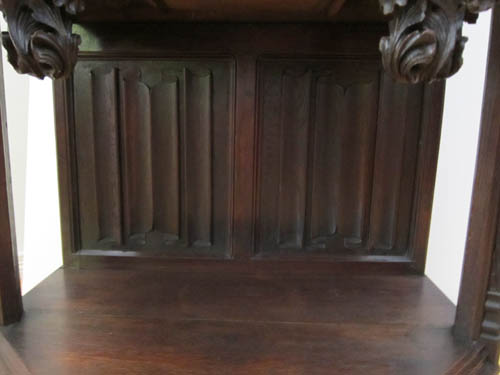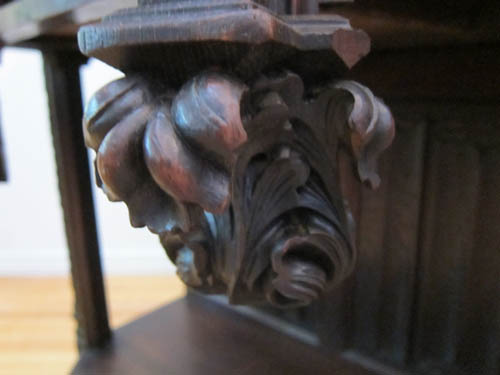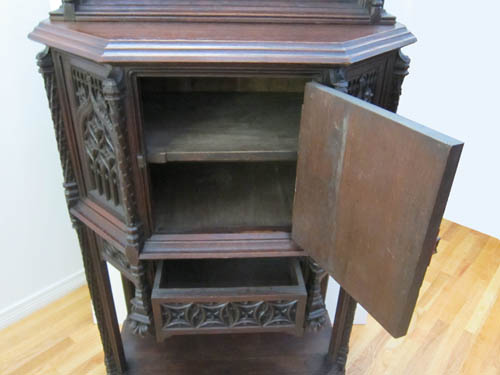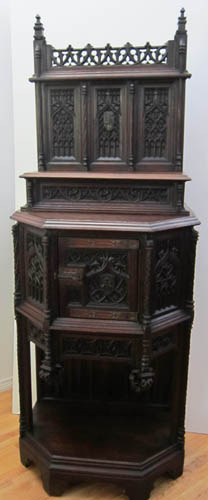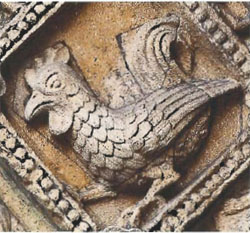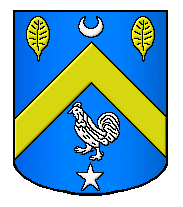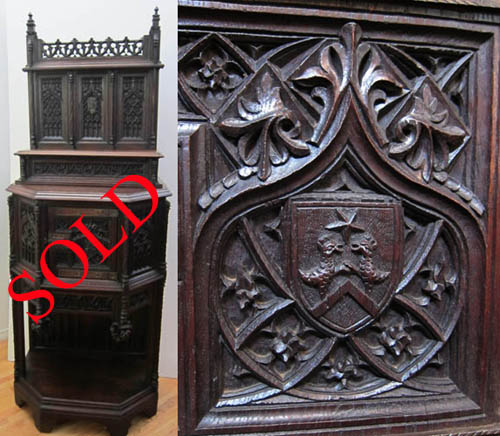
This cabinet was purchased with 5112A as part of a set of dining room furniture. Although it is exuberant in its tracery and heraldry, it does not appear to have been made by the same artist as 5112A. That is not to say that it is not equally brilliant and unique - just smaller and different. If there is a theme uniting the pieces and giving a clue to their provenance, it could be animals - dogs on 5112A and roosters on this piece. Perhaps the pieces came from a country estate where the owners lived closer to nature than their citified counterparts.
In overall shape, the cabinet is a dressoir — a central case above an open pot board — but more compact and narrow than the typical dressoir. The central case is hexagonal in shape, following the late Gothic design favoring more angles and patterns rather than the squared-off box design from an earlier period when the dressoir first evolved from a chest placed on a table.
The ornamentation of the lone door is striking for the elaborate nature of the carving, the heraldry, and, most of all, the shape of the carved panel. In Gothic design it is highly unusual to find asymmetry. Balance and equivalence were central to belief as well as artistry. So to find a panel extending out to the left over the door's closure and a separate, tiny panel below the closure, is unprecedented in pieces we have offered.
The central ogive arch is also distinctive in that it is short and squat with crockets on either side which are much larger than the proportions seen on typical arches. The point of the arch terminates in a leaf pattern, mimicking the crocketing. It extends out from the plane of the tracery panel in what is also a highly unusual flourish.
An intriguing aspect of this central door is the heraldry — a crest with two roosters. The rooster is not uncommon in heraldry, but should not be confused with other fowl, such as chickens, in general, or hens. Traditionally, roosters are associated with dawn but also with fighting to the death. They are symbols of courage and perseverance, combative and stalwart members of the animal kingdom accorded mystical powers to ward off disease and renowned for fearless confrontations with serpents and lions. In medieval lore, the cock's crow was believed to force the demons of the night back into the shadows and rooster became symbolic of the Resurrection.
Roosters were depicted in a number of French Gothic religious buildings, including a lively and richly detailed carving of a cock over the north door of the Cathedral at Metz (see photo, below).
In this crest, it is evident that the fowl are roosters, owing to the cock's comb and the elaborate feathers. They stand on a chevron, derived from the French for "rafter," a heraldic symbol of protection derived from the pointed shape of roofs. Above the roosters is a large five-pointed star. In heraldry, the star can be the symbol of the third son in a family or can reflect, more generally, honor and achievement. The roosters are facing each other and appear to be in combat mode - their beaks open and their feet touching — or are they engaged in some elaborate dance under Venus, the Morning Star, as they prepare to announce the sun's arrival and the start of a new day? We can only speculate. While we found a crest incorporating the three elements of rooster, star, and chevron, connected with a family from central France, it did not involve two roosters and the lay-out was different. Nevertheless, this crest remains an enchanting aspect of this cabinet.
The hardware is original and the door closure is particularly ornate, adding a grand gesture to the unusual and captivating panels comprising the door.
Above the central case is an open shelf backed by three panels of fenestrage or tracery. The two outer ones are identical and the middle panel incorporates another crest, but one whose symbolism we have yet to decipher. As in the door panel, the crocketing on the arches is unusually large but graceful in its depiction of foliage. The base of lancet arches is repeated in the background above the top of the arches. Crowning the cabinet is a rail of open tracery based on interlocking half-moon shapes divided into elliptical subsets. The two finials, framing and projecting above the rail, have been replaced.
Overall, the carving is finely detailed and deftly executed despite the wood being hard, solid oak rather than the somewhat more receptive walnut preferred for the elaborate tracery of Flamboyant Gothic furniture.
The small drawer below the central case is intricately carved in a remarkable pattern involving alternating ellipses of tracery within curved rather than perpendicular shapes. Other elaborate patterns of tracery are included on the side panels of the central case, including a panel incorporating a fleur-de-lys. That the sides are so elaborately and uniquely executed is further proof that the cabinet was an important commission for the cabinet-maker who could otherwise have taken short-cuts using less elaborate designs for the sides and top.
Just below the central case, framing the pot board, are two poignés or fist-shaped clusters of acanthus leaves. They incorporate the motifs of the leaves that form the crocketing on the arches and lend a unifying theme to the overall ornamentation.
The pot board itself is unadorned save for two tall and elegant plis-de-serviette panels comprising the back of the board.
Reference
Ader-Tajan, Collection Bruno Perrier Haute Epoque (Catalog for Sale at Auction on April 6, 1992 at the Hôtel Drouot, Paris); Boccador, Jacqueline, Le Mobilier Français du Moyen Age à la Renaissance (Editions d'Art Monelle Hayot, Saint-Just-en-Chaussée, 1988); Thirion, Jacques, Le Mobilier du Moyen Age et de la Renaissance en France (Editions Faton, Dijon, 1998); Viollet-le-Duc, Eugène, Le Mobilier Médiéval (Georges Bernage, editor) (Editions Heimdal, 2003)
Uses
Overall, this cabinet is perfectly proportioned and eye-catching, a veritable feast of Gothic design in one compact package. The unusual crest should prove fodder for conversation and speculation for generations to come — especially in a dining room, accompanying a meal of coq-au-vin.
